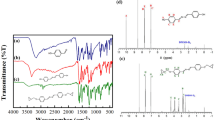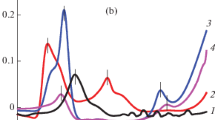Abstract
This article reports the processing and characterization of epoxy resins with near constant molar cross-link density prepared from sequentially reacted amine cross-linking agents. Stoichiometric blends of curing agents with compositions ranging from all polyetheramine to all diaminodiphenylsulfone (DDS) are reacted with an epoxy monomer in a staged curing procedure. The low reactivity of the aromatic amine permits the selective reaction of the aliphatic amine in the first stage. The residual aromatic amine and epoxide functionality are reacted in a second stage at higher temperature. Above approximately 50% DDS content the first stage produces sol glasses which have not reached the gel point. The glass transition temperatures of the partially cured networks decrease monotonically with increasing DDS content. The partially cured networks can be characterized thermally and mechanically above their respective glass transitions without significantly advancing the reaction of the residual DDS and epoxide functionality. The networks formed after the second stage of the cure exhibit thermal and mechanical properties intermediate between those of the two individual amine cured networks, according to composition. The blends do not show any evidence of phase separation across the entire composition range in either the partially cured or fully cured state.





















Similar content being viewed by others
References
Ellis B (1993) Chemistry and technology of epoxy resins. Chapman and Hall, New York
Bucknall CB, Partridge IK (1983) Polymer 24(5):639
Wu WL, Bauer BJ (1989) Polymer 30:1384
Beck Tan NC, Bauer BJ, Plestil J, Barnes JD, Liu D, Matejka L et al (1999) Polymer 40:4603
Wu WL, Hu JT, Hunston DL (1990) Polym Eng Sci 30(14):835
Philipson J (1959) Method and composition for curing epoxy resins. Patent 2891927
Lahlali N, Naffakh M, Dumon M (2005) Polym Eng Sci 45:1581
Wiggins PL (1988) Epoxy curing agent composition. USA patent 4,775,736
Tesch H, Heym M, Doerflinger W, Stutz H, Neumann P, Nissen D, et al (1988) Curable compositions based on epoxy resins. USA patent RE32,628
de Nograro FF, Llano-Ponte R, Mondragon I (1996) Polymer 37(9):1589
Nakajima T, Furukawa H, Tanaka Y, Kurokawa T, Osada Y, Gong JP (2009) Macromolecules 42:2184
Singh NK, Lesser AJ (2010) Macromolecules 44:1480
Thiele JL, Cohen RE (1979) Polym Eng Sci 19(4):284
Bellenger V, Dhaoui W, Verdu J (1990) Polym Eng Sci 30(6):321
Jordan C, Galy J, Pascualt JP (1992) J Appl Polym Sci 46:859
Detwiler AT, Lesser AJ (2010) J Appl Polym Sci 117:1021
Flory PJ (1941) J Am Chem Soc 63:3083
Cook WD, Scott TF, Quay-Thevenon S, Forsythe JS (2004) J Appl Polym Sci 93:1349
Adam G, Gibbs JH (1965) J Chem Phys 43(1):139
Boyer RF (1963) Rubber Chem Technol 46:1303
Hale A, Macosko CW, Bair HE (1991) Macromolecules 24:2610
Lovell R, Windle AH (1990) Polymer 31(4):593
Wu Wl, Bauer BJ (1986) Polymer 27:169
Arruda EM, Boyce MC (1993) Int J Plasticity 9:697
Kovacs AJ, Aklonis JJ, Hutchinson JM, Ramos AR (1979) J Polym Sci: B Polym Phys 17:1097
Lesser AJ, Calzia KJ (2004) J Polym Sci B: Polym Phys 42:2050
Crawford ED, Lesser AJ (1998) J Polym Sci: B Polym Phys 36:1371
van Melick HGH, Govaert LE, Meijer HEH (2003) Polymer 44:2493
Cross A, Haward RN (1978) Polymer 19:677
Treloar LRG (1975) The physics of rubber elasticity. Clarendon Press, Oxford
Arruda EM, Boyce MC, Jayachandran R (1995) Mech Mater 19:193
Haward RN, Thackray G (1968) Proc R Soc Lond A 302:453
Tervoort TA, Govaert LE (2000) J Rheol 44(6):1263
Charlesworth JM (1988) Polym Eng Sci 28(4):230
Porter RS, Johnson JF (1966) Chem Rev 66(1):1
Hoy RS, Robbins MO (2006) J Polym Sci: B Polym Phys 44:3487
Haward RN, Young RJ (1997) The physics of glassy polymers. Chapman and Hall, New York
Wendlandt M, Tervoort TA, Suter UW (2010) J Polym Sci: B Polym Phys 48:1464
Govaert LE, Engels TAP, Wendlandt M, Tervoort T, Suter UW (2008) J Polym Sci: B Polym Phys 46:2475
Lesser AJ, Crawford E (1997) J Appl Polym Sci 66:387
Fox TG, Loshaek S (1955) J Polym Sci 15:371
Espuche E, Galy J, Gerard JF, Pascualt JP, Sautereau H (1995) Macromol Symp 93:107
Robertson RE (1966) J Chem Phys 44(10):3950
Calzia KJ, Lesser AJ (2007) J Mater Sci 32:5229. doi:10.1007/s10853-006-1268-0
Bree HW, Heijboer J, Struik LCE, Tak AGM (1974) J Polym Sci: B Polym Phys 12:1857
Charlesworth JM (1988) Polym Eng Sci 28(4):221
G’Sell C, McKenna GB (1992) Polymer 33(10):2103
Wang X, Gillham JK (1993) J Appl Polym Sci 47:447
Boyce MC, Arruda EM (2000) Rubber Chem Technol 73(3):504
Rivlin RS, Saunders DW (1951) Philos Trans R Soc Lond A 243:251
Bicerano J (2002) Prediction of polymer properties, 3rd edn. Marcel Dekker, Inc., New York
Bicerano J, Sammler RL, Carriere CJ, Seitz JT (1996) J Polym Sci: B Polym Phys 34:2247
Author information
Authors and Affiliations
Corresponding author
Rights and permissions
About this article
Cite this article
Detwiler, A.T., Lesser, A.J. Characterization of double network epoxies with tunable compositions. J Mater Sci 47, 3493–3503 (2012). https://doi.org/10.1007/s10853-011-6182-4
Received:
Accepted:
Published:
Issue Date:
DOI: https://doi.org/10.1007/s10853-011-6182-4




